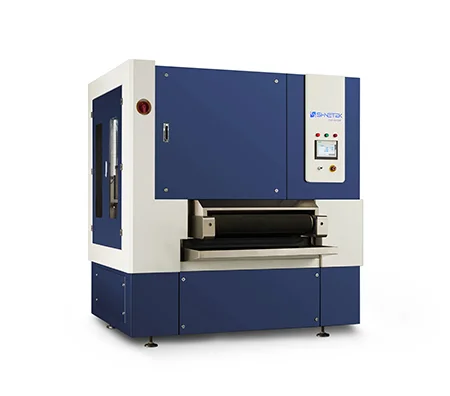- This topic is empty.
-
AuthorPosts
-
2025-07-21 at 4:34 pm #7002
In the demanding world of precision manufacturing, final component quality is not judged solely by dimensional accuracy, but by surface integrity, edge condition, and tactile smoothness. Burrs — microscopic metal projections or leftover material fragments — are often inevitable by-products of machining, drilling, milling, or stamping operations. If not properly addressed, these burrs compromise assembly fit, wear resistance, safety, and aesthetic quality. Enter the rotary deburring machine — a cornerstone solution in modern finishing lines for precision-engineered components. Combining controlled mechanical action with high repeatability, the rotary deburring machine ensures that sharp edges are softened, burrs removed, and part consistency upheld across mass production volumes. This article Shinetek examines the advantages of rotary deburring machines in precision finishing.
What is the Rotary Deburring Machine?

The rotary deburring machine is a high-precision industrial tool designed to remove burrs — unwanted raised edges or material fragments — from the surface of a machined or processed part through rotational action. Unlike linear or vibratory methods, rotary deburring involves the use of spinning tools such as brushes, abrasive wheels, or blades, which are rotated around or against the component's surface to remove imperfections with uniform force and consistency. This type of machine is capable of addressing complex part geometries, including internal holes, cross-drilled passages, and sharp external edges. It is commonly used after CNC machining, stamping, forging, or casting, where precision edge conditioning is essential. With adjustable parameters such as tool rotation speed, contact pressure, and processing angle, the rotary deburring machine offers a highly controlled finishing process, ensuring the removal of burrs without altering critical dimensions of the part. Furthermore, rotary deburring machines can be integrated into automated production lines or operate as standalone workstations, making them ideal for high-volume manufacturing environments that demand speed, repeatability, and exceptional surface quality.
Advantages of Rotary Deburring Machine in Precision Finishing Operations
Uniform Edge Quality and Dimensional Stability
One of the biggest advantages of a rotary deburring machine is its ability to provide uniform edge rounding and consistent burr removal across multiple parts and batches. By maintaining constant contact force and rotational velocity, the machine ensures that all edges are processed evenly — whether internal holes, external contours, or cross-drilled intersections. This uniformity directly contributes to dimensional stability. Unlike aggressive grinding or chemical methods, rotary deburring is finely controllable, which prevents unnecessary material removal. Components retain their tolerance zones while benefiting from enhanced edge integrity, a critical requirement in gear manufacturing, precision bushings, and connector housings.
Reduced Risk of Surface Damage and Microcracking
Manual deburring or high-speed grinding can introduce surface scratches, stress concentrations, or even microcracks due to uncontrolled pressure or heat generation. In contrast, the rotary deburring machine employs controlled abrasion or brushing, resulting in gentle but effective edge finishing. Moreover, when used with non-woven abrasive tools or soft-bristled brushes, the process induces minimal thermal or mechanical stress, making it suitable for parts with complex geometries, thin walls, or heat-sensitive coatings. As a result, manufacturers can achieve high-quality finishes without compromising substrate integrity or introducing latent defects.
Automation and Cycle Time Reduction
Modern rotary deburring machines are designed for integration into automated production cells or standalone robotic systems. With programmable logic controllers (PLCs), HMI interfaces, and auto-calibration features, the machine supports rapid cycle transitions, tool changes, and in-line quality checks. In high-volume settings such as automotive engine component finishing, cycle time per part is a key performance metric. A well-configured rotary deburring machine can process dozens of parts per hour with minimal operator intervention. This not only increases throughput but also reduces reliance on skilled manual labor, lowering labor costs and enhancing consistency.
As manufacturing industries continue to push the limits of complexity, precision, and throughput, finishing operations must evolve to deliver burr-free, reliable components at high speed and repeatability. The rotary deburring machine stands as a proven, high-value solution in this pursuit. With its ability to adapt to diverse geometries, handle multiple materials, and integrate seamlessly into automated lines, it offers manufacturers the performance edge they need in competitive markets. Its contributions go beyond cosmetic improvement — rotary deburring directly impacts part function, assembly efficiency, lifecycle durability, and regulatory compliance. Whether producing high-stakes aerospace components or consumer-grade automotive parts, this machine plays a pivotal role in ensuring that every detail is refined to perfection.
https://www.shinetekgrind.com/How-the-Rotary-Deburring-Machine-Perfects-Industrial-Finishing.html
https://www.shinetekgrind.com/D-Series
http://www.shinetekgrind.com
Suzhou Shinetek Grinding Technology Co., Ltd. -
AuthorPosts
- You must be logged in to reply to this topic.
